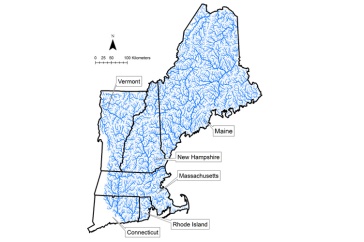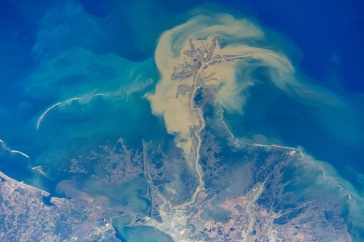
The mouth of the Mississippi River, emptying into the Gulf of Mexico south of New Orleans, Louisiana, is pictured from the International Space Station as it orbited 262 miles above. Credit: Roscosmos/NASA.
A new study from UNH found that a potential U.S. climate policy could lead to significant decline in the nation’s carbon emissions while also reducing the size of the Gulf of Mexico’s dead zone by 3-4% per year.
In the study, published in the journal Proceedings of the National Academy of Sciences (PNAS), researchers explored how adding an extra “social cost” to fossil fuels – which are often essential to produce the fertilizer used in agriculture — could lead to a cascade of effects to numerous systems: CO2 emissions could decline by as much as 50%; however, the cost of fertilizer would rise, leading farmers to apply less to their fields. This could result in less fertilizer runoff into nearby waterways that ultimately contribute to the Gulf of Mexico’s dead zone — a low-oxygen area that struggles with harmful algal blooms that threaten marine life.
“Excessive fertilizer use creates a growing number of water quality concerns so we wanted to explore the consequences of applying a social cost to fossil fuel prices which should reduce fertilizer use and decrease the amount of runoff going into the Mississippi River Basin and on to the Gulf of Mexico, an important fishery in the U.S.,” said Shan Zuidema, research scientist at UNH’s Earth System Research Center and lead author. “Our models showed that with this climate policy, U.S. carbon emissions could significantly decline but we could also see about a 3% to 4% reduction of the Gulf of Mexico dead zone in an average year.”
In the study, published in the journal Proceedings of the National Academy of Sciences (PNAS), researchers from UNH, Purdue University and the University of Wisconsin-Madison used four different models that looked at various factors making up the world economy. They focused on data from the global economy, U.S. agricultural economies, agroecology and hydrology/water quality to capture the impacts of the climate change mitigation policy on agriculture and the resulting water quality co-benefits. They analyzed a policy that would assign a range of social costs to fossil fuel-based CO2 emissions. The policy would raise energy costs and increase the price of nitrogen fertilizer production.
The researchers then considered three different levels of social costs applied to fossil fuels and found at the highest carbon price the cost of nitrogen fertilizer could rise by roughly 90%. This could lead to upwards of a 16% decline in fertilizer application for corn production across the Mississippi River Basin and a roughly 9% decline in fertilizer loss to the environment. Corn and soybean production would decline by about 7%, increasing crop prices by 6%, while nitrate leaching would decline by about 10%. Nitrates entering the environment are removed in various ways as they move through the watershed, so the decline in nitrogen leaving the watershed at the mouth of the Mississippi River was somewhat less (roughly a 9% reduction).
“Implementing a carbon price that reflects its social cost allows the U.S. to meet its commitment to the Paris Accord while significantly improving water quality,” said Tom Hertel, professor of agricultural economics at Purdue University and project principal investigator. “Our models showed that with this range of climate policies, U.S. carbon emissions could decline by 29% to 50%, depending on the stringency of the carbon pricing. This represents 4.6% to 8% of global carbon emissions and satisfies the range of reductions outlined in the Paris Accord.”
Researchers also considered the additional benefits of restored wetlands to mitigate nitrogen loading and improve the low oxygen levels in the Gulf of Mexico and found a targeted wetland restoration scenario approximately doubles the effect of a low to moderate social cost of carbon.
The team hopes these findings provide important context for policy makers to consider all aspects of climate mitigation, as well as for those that want to consider alternatives for reducing contamination to the Gulf of Mexico.
Co-authors include Wilfred Wollheim and Stephen Frolking, both from UNH; Jing Liu, Maksym Chepeliev, David Johnson, Uris Baldos and Tom Hertel, all from Purdue University; and Christopher Kucharik, from the University of Wisconsin-Madison.
Funding for this research was provided by the Innovations at the Nexus of Food, Energy and Water Systems project funded by the National Science Foundation. Partial funding was provided by the New Hampshire Agricultural Experiment Station through the USDA National Institute of Food and Agriculture.
The UNH Institute for the Study of Earth, Oceans, and Space (EOS) is UNH's largest research enterprise, comprising six centers with a focus on interdisciplinary, high-impact research on Earth and climate systems, space science, the marine environment, seafloor mapping and environmental acoustics. With approximately 100 principal investigators managing more than 400 individual grant awards, and with annual expenditures exceeding $95 million, EOS fosters an intellectual and scientific environment that advances visionary scholarship and leadership in world-class and graduate education.
-
Written By:
Robbin Ray ’82 | UNH Marketing | robbin.ray@unh.edu | 603-862-4864



















































